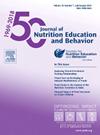食品杂货:一种创新的方法来改善风险纽约人的食品安全
IF 2.3
3区 医学
Q2 EDUCATION, SCIENTIFIC DISCIPLINES
引用次数: 0
摘要
在纽约市(NYC),食品不安全风险在没有保险的居民和糖尿病或高血压患者中更为普遍。为了改善这些群体的食物获取情况,纽约市卫生局与纽约市卫生和医院(H+H)合作,于2023年推出了杂货外卖服务(G2G),每月为使用在线平台购买杂货提供积分。目的评估G2G参与者6个月后的计划信贷使用情况和粮食不安全和饮食的变化。研究设计、设置、参与者的资格要求是H+H(一项针对没有保险的纽约人的医疗保健计划)的NYC Care会员;自我报告的高血压或糖尿病诊断;以及粮食不安全的风险。参与者每月可获得110美元(1-2人家庭)或270美元(3人以上家庭)的信用额度,加上购买农产品的50%折扣,最高可达每月60美元。每月收集程序使用数据。在入组时和6个月后,参与者完成了一项关于食品不安全和行为的自愿调查。可测量的结果/分析总共购买1次以上,每月购买1次以上,并在前6个月内使用农产品折扣的参与者的百分比是根据信贷使用数据计算出来的。粮食不安全状况以6分制来衡量,分数越高表明不安全状况越严重;采用Wilcoxon sign -rank检验比较入组时和6个月时的平均值。使用McNemar试验评估6个月后自我报告饮食的变化。截至2024年5月,在4076名G2G参与者中,94.6%的人在前6个月内至少下了一次订单。在那些曾经下过订单的人(n = 3856)中,75.3%的人每月购买,98.0%的人使用农产品折扣。6个月后,食品不安全的平均变化为-0.43 (p = 0.001,n=228),表明改善,认为饮食一般或较差的百分比从71.6%下降到56.5% (p <;0.001)。结论项目参与者对在线杂货服务的接受度和使用率较高。6个月后,参与者的食品安全评分和自我报告的饮食有了显著改善。资助纽约市本文章由计算机程序翻译,如有差异,请以英文原文为准。
Groceries to Go: An Innovative Approach to Improving Food Security Among At-Risk New Yorkers
Background
In New York City (NYC), risk for food insecurity is more prevalent among uninsured residents and among those with diabetes or hypertension. To improve food access among these groups, the NYC Health Department, in partnership with NYC Health and Hospitals (H+H), launched Groceries to Go (G2G) in 2023, providing monthly credits for purchasing groceries using an online platform.
Objective
To assess program credit usage and changes in food insecurity and diet after 6 months among G2G participants.
Study Design, Settings, Participants
Eligibility requirements were membership in NYC Care at H+H (a healthcare access program for New Yorkers without insurance); self-reported diagnosis of hypertension or diabetes; and risk of food insecurity. Participants received monthly credits of $110 (1-2 person households) or $270 (3+ person households) plus 50% off produce purchases up to $60 per month. Program usage data was collected monthly. At enrollment and after 6 months participants completed a voluntary survey about food insecurity and behavior.
Measurable Outcome/Analysis
The percent of participants that made 1+ purchases in total, 1+ purchases each month, and used the produce discount during their first 6 months was calculated from credit usage data. Food insecurity was measured on a six-point scale, with higher scores indicating greater insecurity; means were compared at enrollment and at 6 months using Wilcoxon signed-rank test. Change in self-reported diet after 6 months was assessed using McNemar tests.
Results
Of 4076 G2G participants enrolled through May 2024, 94.6% placed at least one order in their first 6 months. Of those that ever ordered (n = 3856) 75.3% made monthly purchases, and 98.0% used the produce discount. After 6 months in the program, there was a mean food insecurity change of -0.43 (p = 0.001, n=228) indicating improvement and the percent rating their diet as fair or poor decreased from 71.6% to 56.5% (p < 0.001).
Conclusions
There is high acceptability and usage among program participants in using an online grocery service. After 6-months, there were significant improvements in participants’ food security score and self-reported diet.
Funding
New York City
求助全文
通过发布文献求助,成功后即可免费获取论文全文。
去求助
来源期刊
CiteScore
4.20
自引率
11.50%
发文量
379
审稿时长
44 days
期刊介绍:
The Journal of Nutrition Education and Behavior (JNEB), the official journal of the Society for Nutrition Education and Behavior, is a refereed, scientific periodical that serves as a global resource for all professionals with an interest in nutrition education; nutrition and physical activity behavior theories and intervention outcomes; complementary and alternative medicine related to nutrition behaviors; food environment; food, nutrition, and physical activity communication strategies including technology; nutrition-related economics; food safety education; and scholarship of learning related to these areas.
The purpose of JNEB is to document and disseminate original research and emerging issues and practices relevant to these areas worldwide. The Journal of Nutrition Education and Behavior welcomes evidence-based manuscripts that provide new insights and useful findings related to nutrition education research, practice and policy. The content areas of JNEB reflect the diverse interests in nutrition and physical activity related to public health, nutritional sciences, education, behavioral economics, family and consumer sciences, and eHealth, including the interests of community-based nutrition-practitioners. As the Society''s official journal, JNEB also includes policy statements, issue perspectives, position papers, and member communications.

 求助内容:
求助内容: 应助结果提醒方式:
应助结果提醒方式:


